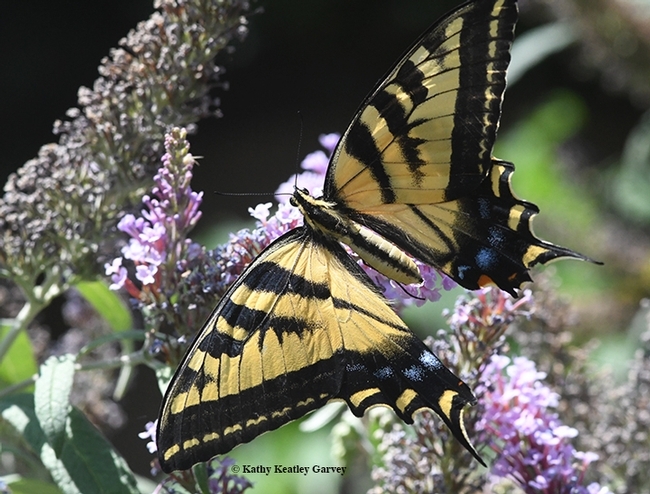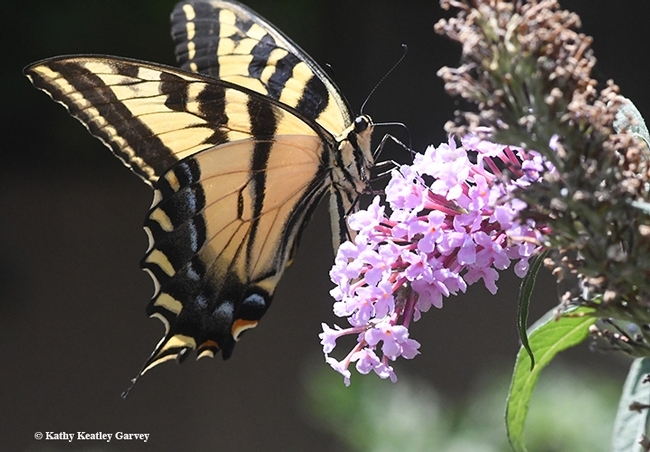- Author: Kathy Keatley Garvey
If you've ever reared a butterfly--from an egg to a caterpillar to a chrysalis to an adult--you know what it feels like.
Like a miracle, to see life unfolding.
Our friend, Marilyn Sexton, aka "Anise Swallowtail Butterfly Mama," showed us her Bohart Museum of Entomology habitat that housed two remaining adult butterflies ready to be freed.
It was a beautiful day in the neighborhood, as Mr. Rogers (Fred Rogers, 1928-2003) sang.
Two glorious butterflies, Papilio zelicaon, burst out of their habitat and headed straight for some rich floral nectar.
It's a common swallowtail butterfly of western North America, and often confused with the Western tiger swallowtail, Papilio rutulus, also in the same range.
Butterfly guru Art Shapiro, UC Davis distinguished professor of evolution and ecology, who has monitored butterfly populations in Central California since 1972, says on his website:
"The anise swallowtail is a complex set of ecological races, or 'ecotypes,' whose seasonality has been adjusted by natural selection to match that of their host plants. Selection for adaptive life-history traits seems to have proceeded much faster than evolution at the level of neutral molecular loci.
"At sea level our populations are strongly multivoltine, with only weak, facultative pupal diapause. They have several generations (late February or March-October) and breed very largely on sweet fennel ('anise'), Foeniculum vulgare, and (in the first half of the season) poison hemlock, Conium maculatum. Both of these are naturalized European weeds."
Weeds or not, butterflies or not, anise swallowtails are spectacular.
Yes, 'twas a beautiful day in the neighborhood...
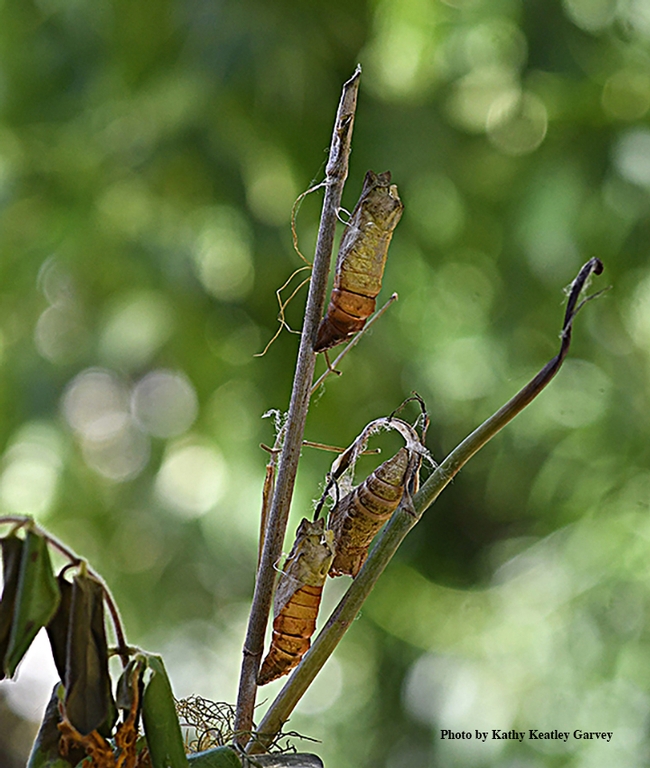
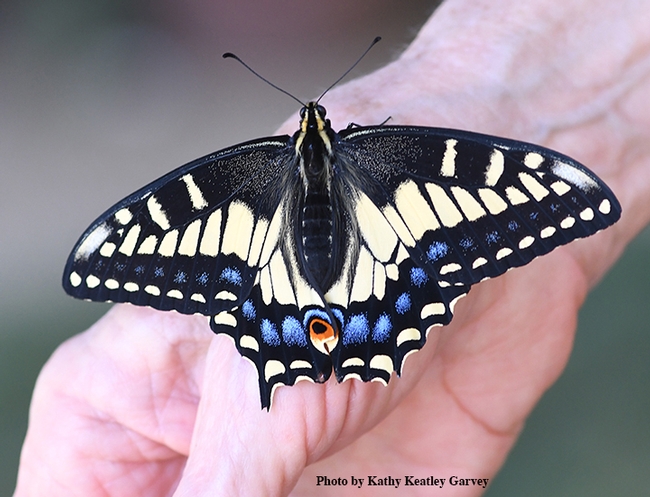
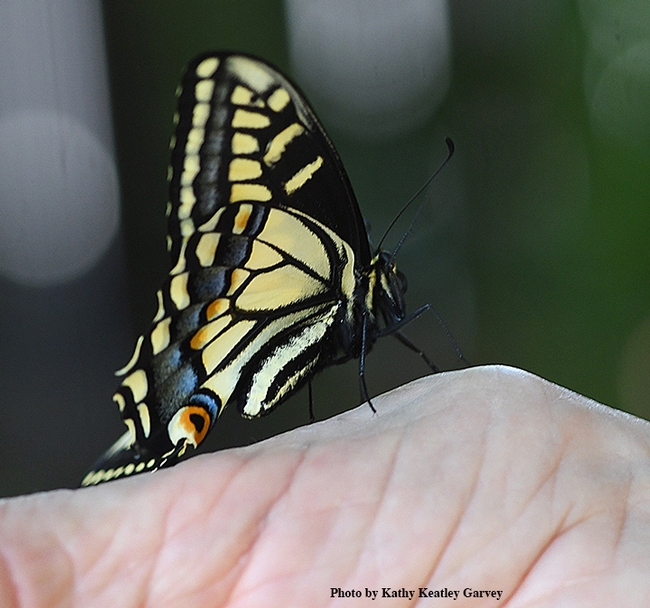
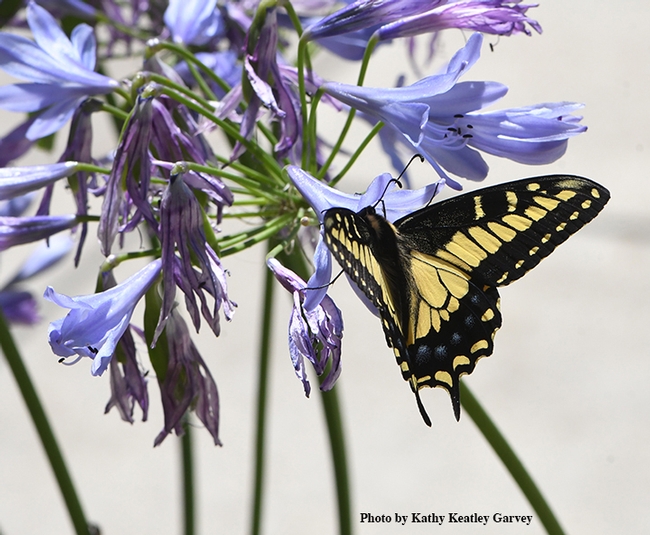
- Author: Kathy Keatley Garvey
It was "hit and miss."
The predators hit, and they missed.
Oh sure, they took a chunk out of these Western tiger swallowtails, but as they say, "a miss is as good as a mile."
The predators? Could have been a hungry bird, praying mantis, or a spider.
The Western tiger swallowtail, Papilio rutulus, a showpiece throughout western North America, populates urban parks and gardens. In color, it's a striking yellow and black, with spots of blue and orange near its tail. Its magnificent wingspan can measure 3 to 4 inches.
If you like to take images of butterflies, don't pass up the Western tiger swallowtail that's missing a chunk here and there. They don't have to be "picture perfect" to photograph--or to enjoy one of the wonders of nature.
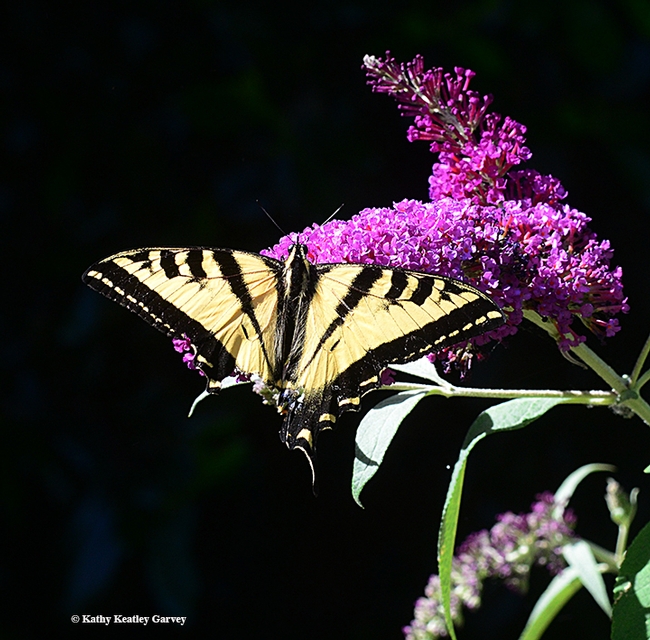
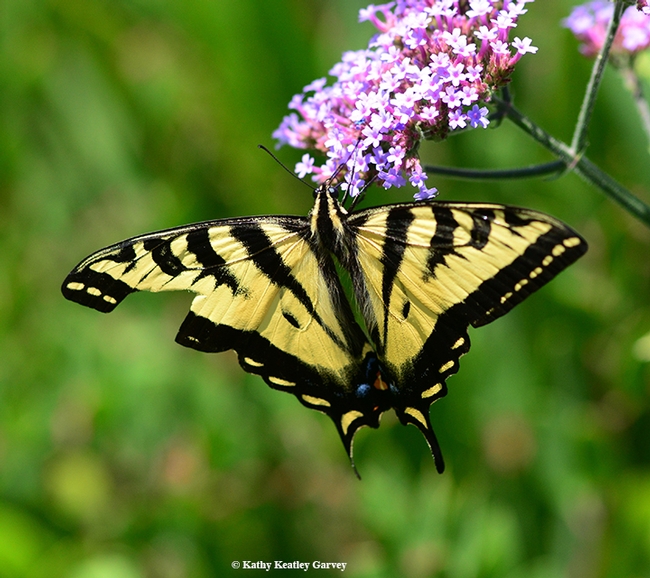
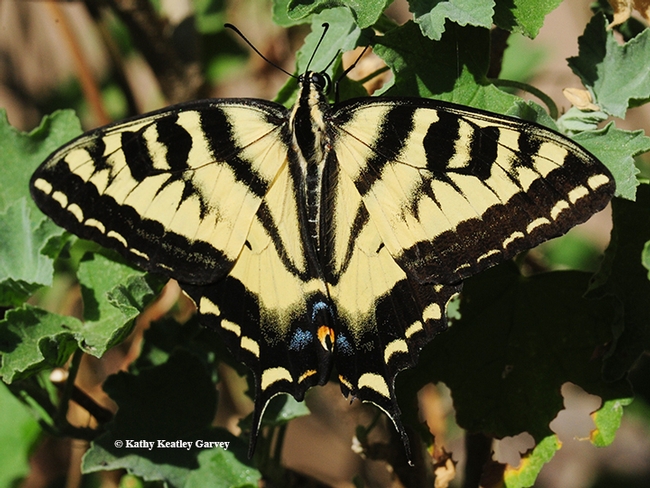
- Author: Kathy Keatley Garvey
If you visit the Kate Frey Pollinator Garden at Sonoma Cornerstone--and you should, especially during National Pollinator Week--you'll see honey bees, bumble bees, butterflies and hummingbirds, among other pollinators.
Today we spotted a male monarch patrolling the milkweed in search of a female, and a Western tiger swallowtail nectaring alternately on Verbena and on Salvia 'indigo spires.'
About that Western tiger swallowtail--it was missing a chunk of its left forewing. A predator--maybe a bird or a praying mantis--tried to nail it but missed.
About that garden--it's the work of Kate Frey, a world-class pollinator garden designer, pollinator advocate and author. When she addressed the 2018 UC Davis Bee Symposium on "Designing Bee Friendly Gardens," she said that "Bee gardens make us happy."
They do indeed.
Frey, a resident of Hopland, co-authored the award-winning book, The Bee Friendly Garden, with Professor Gretchen LeBuhn of San Francisco State University. It's a book that details how to design an abundant, flower-filled garden that nurtures bees and supports biodiversity.
And make us happy.
About that butterfly--the Western tiger swallowtail, Papilio rutulus, is common throughout western North America and is often seen in urban parks and gardens. In color, it's a striking yellow and black, with spots of blue and orange near its tail. Its wingspan can measure 3 to 4 inches.
It's "basically a species of riparian forest, where it glides majestically back and forth along the watercourse," says butterfly guru Art Shapiro, UC Davis distinguished professor of evolution and ecology on his website."It has expanded into older urban neighborhoods where several of its host genera are grown as shade trees, and behaves as if the street were a watercourse."
When we left Sonoma Cornerstone today, the "tiger" was still floating, fluttering and flittering, quite majestically, too, throughout the garden, despite the wear and tear on its left forewing.
Survival of the flittest...
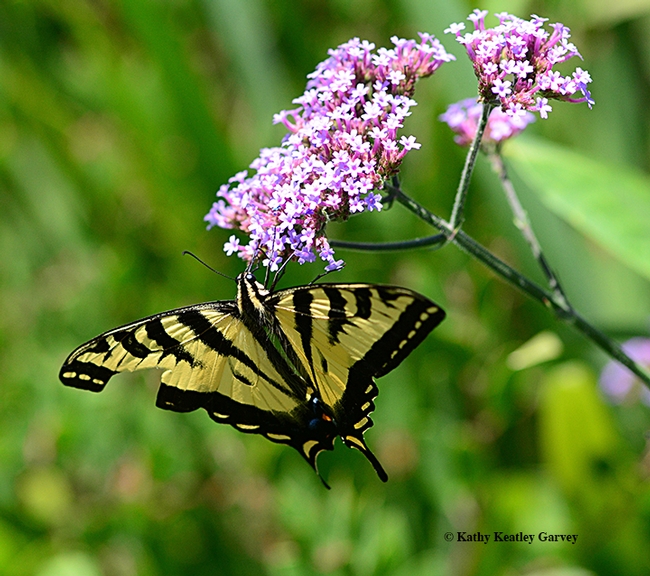
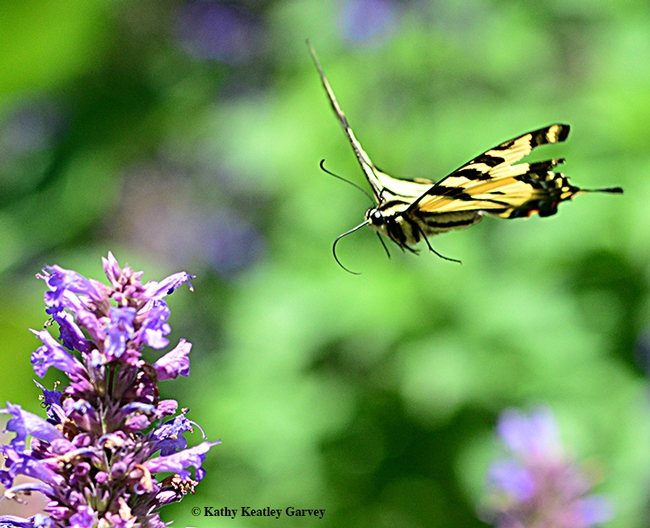
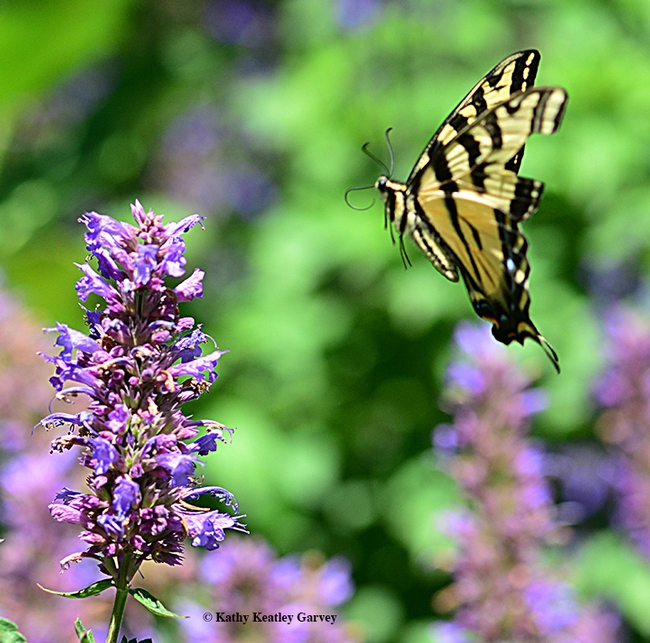
- Author: Kathy Keatley Garvey

If you've ever wanted to converse with butterfly guru Art Shapiro, UC Davis distinguished professor of evolution and ecology, about "butterflies and the apocalypse" and sip a beer (or another beverage) at the bar at the same time, here's your chance.
The Davis Science Café has booked "A Conversation with Arthur Shapiro: Butterflies as Heralds of the Apocalypse" at 5:30 p.m., Wednesday, April 10 in the G Street Wunderbar, located at 228 G St., Davis. The event, hosted by professor Jared Shaw, professor and interim department chair of the UC Davis Department of Chemistry, is free and open to the public (but the refreshments are not).
Shapiro has monitored butterfly population trends on a transect across central California since 1972. The 10 sites stretch from the Sacramento River Delta through the Sacramento Valley and Sierra Nevada mountains to the high desert of the Western Great Basin. The largest and oldest database in North America, it was recently cited by British conservation biologist Chris Thomas in a worldwide study of insect biomass.
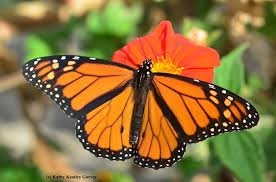
What's going on with the butterflies?
The overwintering western population of the monarch butterfly on the central California coast declined 86 percent last winter, the Xerces Society for Invertebrate Conservation indicates on its website. "Working at a conservation nonprofit means that we often come across bad news, but the results from this winter's Western Monarch Thanksgiving Count left us shocked: an all-time record low of 28,429 monarchs at 213 sites. This number is an 86% drop from the previous count done at Thanksgiving 2017, when 192,668 monarchs were counted at 263 sites (comparing only the sites monitored in both years)—and a dizzying 99.4% decline from the numbers present in the 1980s (Schultz et al. 2017). In short, only one of every 160 monarchs present in the 1980s exists today."
At the 2018 Butterfly Summit at Annie's Annuals and Perennials in Richmond, Shapiro told the crowd that "The vast majority of the butterflies we monitor are emerging earlier in the year now than they were in the 1970s."
His research shows that not only are butterflies coming out earlier, but "we also find trends in population and species richness."
Shapiro, a member of the UC Davis faculty since 1971 and author of the book, Field Guide to Butterflies of the San Francisco Bay Area and Sacramento Valley Regions, said that "in a nutshell, at low elevations, butterfly faunas have been declining slowly until 1999. In 1999, 17 species had an abrupt fall in abundance, spontaneously. On its face, this was a non-random event. The decline was then rapid from 1999 to the onset of the recent drought and then things went up again."
Science Café, initially supported by the National Science Foundation, is currently supported by the Department of Chemistry and Division of Mathematical and Physical Sciences and promoted by Capital Science Communicators.
Science Café sessions are hosted the second Wednesday of each month. Topics so far this year? Plant ecologist Mark Schwartz of the UC Davis Department Environmental Sciences and Policy held forth at the March session on "Does California Have a Wildfire Problem? Can It Be Fixed?" The February session featured Professor Roland Faller of the UC Davis Department of Chemical Engineering on "Using Computers to Understand Materials: From Proteins to Semiconductors" while Professor Denis Marcellin-Little of the UC Davis School of Veterinary Medicine's Surgical and Radiological Sciences discussed "Don't Try That at Home; High-End 3D Printing in Orthopedic Surgery" at the January session.
So it's butterflies and the apocalypse on April 10. Ask your questions, sip an adult beverage (or another beverage) and enjoy the evening!
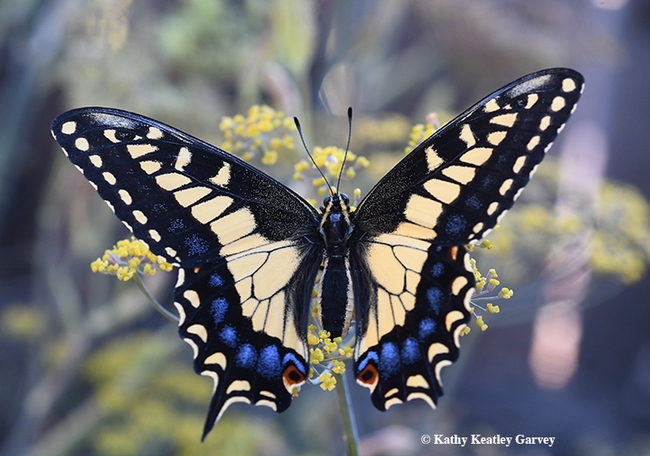
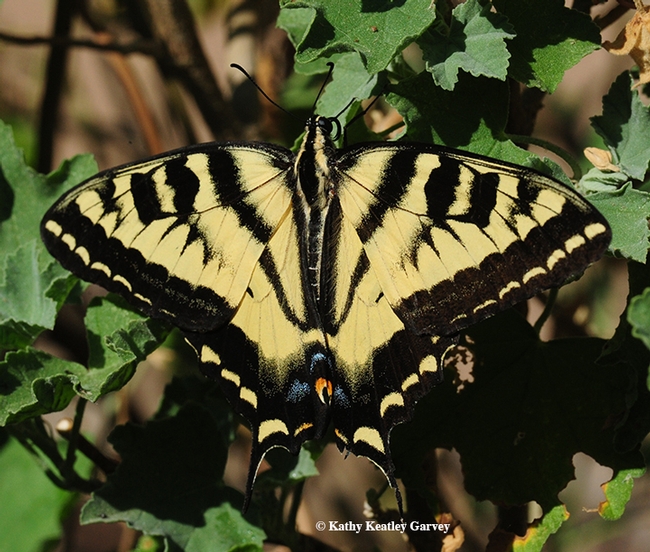
- Author: Kathy Keatley Garvey
It's Thanksgiving Day, and what better day to stop and be thankful for not only family and friends, but for the beauty around us.
That would include insects, including the stunning Western tiger swallowtail (Papilio rutulus).
Last summer we enjoyed watching a very gravid female, with a three-to-four-inch wingspan, nectaring on a butterfly bush (Buddleia davidii) in our Vacaville pollinator garden.
She also nectared on Verbena before departing--probably to lay her eggs on a nearby host plant, liquidambar (sweet gum) or a sycamore.
For just a few minutes, the Western tiger swallowtail graced our pollinator garden with her breathtaking beauty. We are thankful for her presence, and the presence of all the pollinators, past, present and future, in our little pollinator garden.
"Without the actions of pollinators, agricultural economies, our food supply, and surrounding landscapes would collapse," points out the Pollinator Partnership. "Birds, bats, bees, butterflies, beetles, and other small mammals that pollinate plants are responsible for bringing us one out of every three bites of food."
Happy Thanksgiving!
